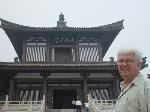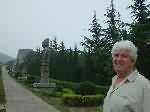- Getting around Lijiang. Dont stay in the Old Towns more than 2 days, there is nothing to do. KRISS Oct 9, 2013 05:46
- 2013 Beijing Temple Fair BENNYLAU Feb 26, 2013 03:29
- Malaysian traveling from KUL - LAX vis Shanghai PVG ZATI_DY Jan 3, 2013 20:15
Famen Temple and Qianling Tomb Stir My Soul, While A Hostess in Red Renews My Heart
- Views: 3516
- |Vote: 0 0
- |Add to Favorites
- |Recommend to Friends
What do I know? This is my first visit to China and I've been here less than three months. So, my friend Nelson, a big-time travel guide, invites me to join him and Rose, his wife. Just a small group of us drove in a van to see Famen Temple and Qianling Tomb. And we experienced a unique meal.
I felt surprise at my day's innate beauty and meaning.
You can get to Famen Temple and Qianling Tomb from Xi'an's down town train station, where a stone's throw away you catch a bus west to Fu Feng county. Famen Temple is only 73 miles west of Xi'an. Qianling Tomb is closer, only 49 miles west. I visited Famen Temple first, next enjoyed a peasant meal, then finished up the day at Qianling Tomb.
On our short drive we followed the first few miles of the ancient Silk Road.
Think of that, I told myself. I traveled the same 2000 year old trading path as thousands before me. Only they were on four legged beasts, or, themselves, walking. The Silk Road, actually a network of roadways, stretched from Xian on the east to Rome on the west. Silk and horses, spices, tea, even religion, traveled the same ruts.
The images I hold of Famen Temple include the tall rebuilt pagoda and recently discovered underground temple. I enjoyed the resplendent architecture of the beautiful recently-built museums with ancient-style turned up roof corners, more so with their holdings of thousands of archeological relics. I felt impressions from the sacred finger bones of the original Buddha found in the search of relics that changed China.
I walked around hungry most of the time I was there, cudda done better if there was a nice sit-down restaurant in the buildings complex.
In the 1980s they rebuilt the Famen Temple which collapsed unexpectedly. In rebuilding, they discovered an undisturbed underground temple, which became one of China's greatest archeological discoveries. Thousands of intact historic articles, now housed in the new adjacent museums, include items of gold, silver, bronze, silk, jade and more. Professionals analyzed the artifacts. The life and culture of this early era became clearer. From their analysis we now better understand daily life, political events and leaders, and religious practices of this 1300 year-ago Tang dynasty.
To me, it was more exciting to learn the underground structure was a temple; a sacred place of worship, where religious objects resided. And, through contemporary research, experts now say it was from this underground place of worship, and an early above-ground site, that a new religious culture in China emerged.
Most important of all artifacts, because of their honored position and precious encasements, remains the translucent finger bones of Buddhism's founder, Shakyamuni.
The reverence and worship given to the bones, and to Buddhism by the Emperor and his family, ultimately the nation, brought about change in China. And, then, Xi'an became both the religious center and the political capital of China.
Today, Chinese people sport beliefs, values, interests. These come from other sources as well, certainly Confucius, but significantly from the Famen Temple and Buddhism.
And that's why I'd guess I experience courteous, kind, caring, go-outta-their-way Chinese.
The Famen Temple epitomizes the values of that day's peoples, in the Tang Society: Poise, boldness, profundity, diligence and the intelligence of laboring people, I learned.
Nearby in the afternoon, along the ancient Silk Road, I visited a small village.
The village presented downtown area lean-to grass-thatched stores, with two and three wheel bicycles everywhere for hauling and personal transportation. Outlying rust-colored clay brick row-houses held humble Chinese farmers. Small brick enclosures, in front of each row-house served as an outhouse.
I arrived at an earlier-chosen row house with my travel group. Inside, floors were tiled. Real tile. I saw wood chairs, a padded sofa, wood cabinets with foot lockers on top. With recent electricity, this farmer installed a bottled water dispenser to supply heated water, the Chinese favorite drink. In the corner I noticed a large screen TV with a DVD player.
Our meal, memorable for its presentation, not its taste, consisted of home-made noodles, baked flat-bread, scrambled eggs with sliced green beans, flour curd, pancakes, sliced cucumber with red pepper and vinegar. I drank a warm bottled coke.
Earlier I walked around the house. In the bedroom I viewed the bed, a solid structure with wood edges, with a flat clay surface for sleeping. Clay works, cool in summer, warmed by an under-the-bed fire in winter. I laid a moment on the bed. It felt like concrete, punishing.
The kitchen with a brick floor and decorated edge tiles had no cupboards, no refrigerator. A few knee-high shelves held dishes, foodstuffs. I spied a large brick oven with smoke swirling into the room, to the vaulted ceiling's exterior vent. Pans warmed on top of the stove. In the corner I noticed a large round wheat bin. A little brown-faced girl stirred the green beans in the pan.
Our cook stood five feet in height, aged fifty, in a red sweater. Her face red, she wore black-and-white striped pants, used the world's grittiest, dirtiest gray-black cloth to wipe kitchen surfaces, her hands. I woulda felt better not to have seen that once-white cloth.
In the brick-fenced back yard, devoid of vegetation, a brown dog strained at his leash, wagged his tail, begging his own dinner.
Our meal complete, we bid sincere thank-filled goodbyes to our hostess, I felt the deep emotions of empathy toward a totally unexpected culture, the Chinese peasant farmer.
We then moved on in our van to Qianling Tomb, a few miles away, which left me with a lasting impression.
The site, a few miles square, is actually a small ancient city. But a city for the dead, and for today's living to visit. It shows a long boulevard down the middle, massive carved figures on either side, a bevy of headless sculpted marble funeral visitors, the tomb of China's only female Emperor, and more distant tombs, one of the Emperor and of various royal figures.
The sculpted headless visitors, representing dignitaries from nearby countries attending the Emperor's long-ago funeral, consisted of about 60 statues in ranks. The detail of the sculptors's chisel speaks skill, yet a later vandalous act cut off the heads of all. I stood, mystified, wishing to see the original works.
The female Empress, Wu Zetian, who died about 700 AD, directed that the customary stone obelisk intended after death to trumpet the Emperor's achievements, be left blank. It's the only one in China like that.
Now I'm recalling these images, as I write, and remember a few special feelings.
First, I never expected to see an expansive long and broad roadway from one end of this complex to the other. Sure, maybe today, but not first built over a millennium ago. This roadway, rebuilt to reflect the original, invites your steps across its unrestrained gray stones.
Second, the entire site is loaded with beautiful greenery among the statuary. Trees, lawns, flowers lavish the eye among ancient monoliths.
At the far end of the broad street a vendor woman pestered me relentlessly, in her rudimentary English, to buy a small trinket. At first I mistakenly examined her hand-crafted item. Falsely encouraged, she continued her long-term distraction, by its end a memorable annoyance.
Overall, the site astonished me by its presentation of resplendent detail left by the sculptor's chisel 1300 long years ago.
What do I know? China is changing fast. In economic terms. But its belief system, its systems of ethics, its kindness, its caring, has its roots in its past.
Famen Temple, Qianling Tomb, and deeply important, a peasant farmer's meal, all spoke to me of China's historic and present values.
c2005 P. Tripp






 Copyright © 1998-2026 All rights reserved.
Copyright © 1998-2026 All rights reserved.